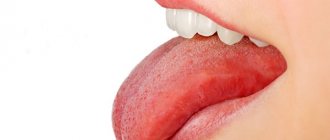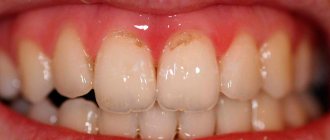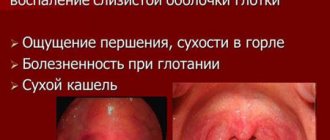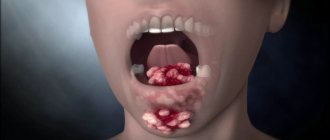Why did the tongue change color?
“Crimson tongue” is not just a description of the color of a muscular organ, it is an existing medical term. There may be several reasons why it turns a brighter color and they are not always dangerous to health. However, this may be an indicator of the presence of a fairly serious disease that requires immediate diagnosis and treatment.
Raspberry tongue in an adult
Do not forget that color changes can be caused by eating highly colored foods such as beets. So before you sound the alarm, remember what you ate for lunch today. If there were no such products in the diet, then the reasons for redness may be as follows:
- liver diseases;
- Gunter's glossitis is a pathological inflammation of the mucous membrane;
- sore throat - fever and inflammation;
- problems with the gastrointestinal tract.
The last point can manifest itself in different ways. A new formation of a different color may appear on the surface, and plaque may be observed at the edges. Or vice versa, only the tip of the muscle will be painted a different color. It is not for nothing that a competent specialist begins examining patients with the oral cavity; the location and nature of the spots can tell a lot about the nature of the disease.
Causes of a red tongue in an adult
The appearance of a red tint is most often caused by inflammation of the taste buds. Redness of the receptors can be caused by thermal reasons - consuming too hot or cold food.
The cause of redness is a chemical burn, which can also be caused by vomiting, since gastric juice, which has strong chemical properties, enters the oral cavity.
Mechanical trauma can also cause redness. The muscle can be injured by a toothbrush, dishes, candy, or, ultimately, simply biting, which leads to inflammation and redness.
Any inflammatory processes in the body that were caused by a virus or infection can also be reflected on the surface of the tongue.
Causes of pale pink color
If a darker color indicates inflammatory processes, then the pallor of this muscular organ most often indicates anemia - a violation of hemoglobin levels. This shade can also appear with vitamin deficiency, malnutrition and sudden weight loss. This problem can almost always be solved with a balanced diet.
Diseases that cause discoloration
First of all, it is necessary to understand the reasons why such a change occurred. There may be several of them.
The most common, in addition to those described above, are the following:
- a number of infectious diseases;
- scarlet fever;
- pneumonia;
- inflammatory process in the stomach - gastritis;
- severe degrees of poisoning;
- renal failure;
- lack of vitamin B 12.
Map of diseases of internal organs by language
Scientists believe that the tip of the tongue is connected to the heart, the central part - to the stomach and pancreas, the back part - to the kidneys, the right lobe of the tongue - to the spleen and right lung, the left - to the liver and left lung. If strong changes occur in any area, it means there are problems with one or another organ.
This map will help you identify tongue disease by color and location.
Redness:
- at the base - impaired renal function;
- in the middle - diseases of the colon;
- at the tip - problems with the cardiovascular system;
- front part - weak lungs, breathing problems;
- the central part is stomach diseases.
Small cracks located throughout the entire area of the mucosa appear with intestinal diseases.
Changes in the fold in the middle of the organ:
- transformation of shape - problems with the spinal column;
- deviation of the fold to the right - back pain;
- deviation to the left – displacement of the cervical vertebrae;
Trembling in the tongue may indicate severe stress or a disorder of the nervous system.
When diagnosing diseases by the color of the tongue, additional symptoms should be taken into account, since the same shade of the tongue characterizes both problems that do not require serious intervention and diseases that require immediate hospitalization.
Cirrhosis of the liver
A red “varnished” tongue is often found in patients with cirrhosis of the liver.
A red “lacquered” tongue is often found in patients with cirrhosis of the liver, a chronic disease characterized by the formation of fibrous tissue in this organ. This is a deadly disease, from which it is almost impossible to completely recover if it is fully formed - the only reliable option is a liver transplant.
Otherwise, patients begin to complain of weakness, dyspepsia, fever and joint pain. Next, asthenia occurs and weight loss develops, and the liver itself increases in size and becomes deformed. At this stage, the patient is prescribed a strict diet, especially since he begins to suffer from a constant feeling of nausea and vomiting. In the terminal stage of cirrhosis, jaundice develops, swelling of the legs and varicose veins of the gastrointestinal tract occur, followed by bleeding - often fatal.
To prevent the occurrence of cirrhosis, doctors recommend following a proper diet and avoiding alcohol consumption.
WHAT TO DO WHEN A CHILD HAS A CARRIBON TONGUE?
A crimson tongue can be a symptom of a disease, but the procedure largely depends on its cause. If you have alarming symptoms, you should consult a doctor.
Treatment of scarlet fever will be based on the use of an appropriate antibiotic
For Kawasaki disease, it is important to start treatment as early as possible. It involves the use of infusions of immunoglobulins, acetylsalicylic acid, and sometimes steroids
Vitamin deficiencies may require their use, changes in diet or treatment of diseases that result (for example, nonspecific intestinal inflammation). Large amounts of vitamin B12 are found in animal products such as meat, milk, fish, and eggs. Vegetables and fruits rich in folic acid include spinach, broccoli, legumes, kiwi, and oranges. The source of iron for the body can be, for example, liver, red meat, legumes, nuts, cocoa. If the cause of glossitis is a fungal infection, it requires treatment with appropriate antifungal drugs.
Other reasons
The cause of redness of the tongue in children can be iron deficiency anemia. In this case, we are talking about a lack of vitamins such as B9 or B12 in the body. At the same time, the papillae themselves begin to gradually atrophy, and the surface of this organ becomes smooth.
To make an accurate diagnosis, the child needs to donate blood. If anemia is confirmed, parents will need to adjust their child's daily diet. It should largely consist of foods containing iron; in addition, the baby is prescribed special vitamins.
If the tongue is not completely red, but such a change is observed in spots, then we can talk about an inflammatory process occurring in the oral cavity. The most common cause is stomatitis. Additionally, white spots appear on the mucous membrane of the cheeks and painful ulcers form. The smell from the mouth becomes unpleasant, the child may be capricious and refuse to eat. As a home treatment, experts recommend rinsing with a decoction of chamomile and soda. When a child has a red tongue and lips, this may indicate problems occurring in the intestines and gastric tract. Also, such a sign may appear after the baby has been taking antibacterial medications for a long time. In this case, first the main treatment will be aimed at eliminating stomach and intestinal ailments. In this case, the mouth itself should be rinsed with sage decoction twice a day.
Red spots on the surface of this organ may appear due to the development of an inflammatory process such as glossitis. This disease occurs against the background of the negative impact of pathogenic microorganisms, especially if there are small microcracks in the tongue. The child experiences the following symptoms:
- soft tissues swell;
- the mouth feels dry;
- it becomes difficult to talk;
- it is impossible to eat normally.
Subsequently, painful erosion develops and occurs in place of the red spots. In any of the above cases, a consultation with a pediatrician is necessary, who, if necessary, will refer the baby for consultation to the necessary specialist.
Raspberry-colored tongue in a child is common, especially in the area of its tip. This phenomenon sometimes appears due to the fact that the baby has eaten too spicy or hot food. In some cases, a change in color indicates an allergic reaction to a particular product. If the baby is no longer bothered by any symptoms, he eats well, and his physiological state does not change, then parents should not worry.
Usually this condition goes away on its own, on its own. But if this sign remains noticeable in your child for some time, and the tip of the tongue becomes painful, you should consult a doctor. You should not try to solve this problem yourself, since a change in the color of the oral cavity occurs against the background of the development of a serious disease that requires immediate treatment.
Inflammation
The most common reason leading to a change in the color of the mucous surface of the tongue is its inflammation. The etiology of the process includes a complex of probable factors, so all types of inflammation of the tongue were combined into a common group of diseases called glossitis. All types of glossitis cause the tongue to become discolored, but not all cases are red.
In addition, hyperemia is not the only symptom of inflammation, although a red tongue may indicate the onset of the disease. Types of glossitis that can lead to redness of the mucous membrane of the tongue are as follows:
- desquamative;
- Gunter's;
- diamond-shaped;
- catarrhal;
- atrophic;
- allergic.
All types of glossitis cause the tongue to become discolored, but not all cases are red.
Depending on the type of glossitis, the features of redness of the tongue (partial or complete) and the shade of red may vary. To make a preliminary diagnosis, it will be necessary to analyze the remaining symptoms, some of which are characteristic only of one type of disease, and the other part relates to the general clinical picture.
One of the most common signs is swelling of the tongue, as well as plaque on its surface and impaired salivation. In addition, small ulcers or erosions may appear in the mouth and tongue, causing an unpleasant odor, and the patient may experience a slight increase in temperature.
Important! Treatment of glossitis is primarily symptomatic and is based on the use of antiseptics, anti-inflammatory and anesthetic agents. If the inflammation is the result of some internal disease, then this cause will need to be eliminated, otherwise glossitis will recur.
Lacquered tongue
When examining the tongue, the doctor determines its color, shape, swelling, thickness, moisture, teeth marks, the severity of the vessels under the tongue, the color and nature of plaque. A healthy person's tongue is pink, clean and shiny; plaque indicates the presence of some disease. An equally important indicator is the violation of the relief of the tongue, the appearance of various grooves. This often indicates a violation of vitamin metabolism.
The organ appears varnished as a result of atrophy of its papillae. With some pathologies, the number of papillae decreases, sometimes they disappear altogether. As a result, it looks smooth, shiny, as if varnished. This condition is typical for malignant tumors of the stomach, vitamin B12 deficiency, and chronic colitis.
The smooth surface of the tongue, the so-called varnished tongue, often appears with iron deficiency and B12 deficiency anemia
A type of “varnished” tongue includes the so-called “chessboard” tongue, which is covered with a difficult-to-remove coating of black-brown color, with cracks resembling a chessboard.
This happens with pellagra (deficiency of nicotinic acid and vitamin B). In the late stage of pellagra, the tongue acquires a red tint with a varnished surface - “cardinal tongue”.
A disease that causes a varnished tongue
A smooth surface of the tongue, the so-called “polished” or “varnished” tongue, often appears with iron deficiency and B12 deficiency (pernicious) anemia, as well as with a deficiency of vitamins B2 and PP. The factors that lead to such changes in the mucous membrane of the tongue also affect the mucous membrane of the stomach and intestines: the same changes occur there - atrophy of the gastric mucosa.
Vitamin B12 is necessary for normal hematopoiesis, the formation of epithelial cells, the functioning of the nervous system (participates in the formation of myelin), growth and regeneration processes.
The lacquered tongue is observed:
- megaloblastic anemia (pernicious anemia, pernicious anemia, Addison-Biermer anemia);
- lesions of the digestive tract (the tongue becomes bright red, smooth, highly sensitive to chemical irritants, atrophy of the gastric mucosa and achylia are noted);
- disorders of the nervous system (paresthesia, pain, gait disturbances).
The crimson lacquered tongue is characteristic
The reasons for changes in the color and tongue to raspberry color in adults may be gastritis, pneumonia, poisoning, lack of vitamin B12
The reasons for the change in the color of the tongue to crimson in adults may be gastritis; pneumonia; poisoning; lack of vitamin B12. A raspberry tongue may be associated with chronic liver disease.
Problems with the gastrointestinal tract, in particular gastritis, will be indicated by a bright crimson tongue coated. At the same time, the intensity of plaque accumulation will be uneven: there will be less of it along the edges and at the tip, and more in the center. At the same time, the appearance of a burning sensation on the tongue indicates a decrease in stomach acidity.
With a lack of vitamin B12, a severe form of anemia may occur. It develops against the background of poor absorption of vitamin B12 in the body or its insufficient intake from food. Nerve cells and bone marrow especially suffer from vitamin B12 deficiency. One of the signs of anemia is a raspberry lacquered tongue.
Red lacquered tongue
“Red lacquered” tongue, or atrophic glossitis (the surface of the tongue is bright red, shiny, smooth due to atrophy (death) of the taste buds) - stomach cancer (a malignant tumor arising from the epithelium (surface cells of the stomach)), chronic colitis (inflammation colon), malabsorption of nutrients in the intestine, vitamin B12 deficiency, xerostomia (dry mouth), candidiasis.
- https://si-yanie.com/smartblog/308_diagnostika-po-yazyku.html
- https://www.remedium.ru/doctor/detail.php?ID=2993
- https://buzovanovosti.ru/aksessuary/raspberry-tongue-in-adult-causes-diagnosis-of-diseases-by-language.html
Post Views: 173
Anemia
Anemia, also called anemia, is characterized by a low concentration of hemoglobin in the blood, and its different types differ in color, severity and other characteristics. One of the varieties is B12 deficiency anemia, also called Addison-Birmer disease, a feature of which is a lack of vitamin B12 in the body, which is necessary for the normal functioning of the bone marrow and central nervous system.
A red tongue is one of the symptoms of anemia.
Frequent accompaniments of this disease are neurological disorders: numbness of the limbs and ataxia due to the death of nerve cells. A red tongue is also one of the symptoms of this type of anemia, and as the disease progresses, it takes on a “varnished” appearance caused by damage to its surface.
Additional Information . In addition to the obvious cause of the disease in the form of a lack of vitamin B12 in the diet, the development of this anemia is influenced by some disorders and diseases of the gastrointestinal tract (including helminths and cancer), as well as heredity.
Scarlet fever
Tongue with scarlet fever.
Another probable cause that can provoke redness of the mucous membrane of the tongue is scarlet fever, an infectious disease caused by streptococcus. The disease is contagious and is transmitted both from a sick person to a healthy person, as well as from a recently ill person or simply a carrier.
Scarlet fever is accompanied by a whole range of symptoms, one of which is the so-called crimson tongue: a few days after the onset of the disease, the mucous membrane of the tongue becomes bright red and granular in appearance. Other signs of the disease look like this:
- fever;
- headache;
- malaise;
- small rash;
- angina;
- exfoliation of the skin in the final phase.
Treatment of scarlet fever most often takes place at home, while the patient is prescribed to remain in bed, drink plenty of warm liquids, and follow a gentle diet. Drug therapy includes, first of all, the use of penicillin-based antibiotics (Phenoxymethylpenicillin, Amoxicillin, Ampicillin and others)
It is equally important to support the patient’s immunity through the use of vitamins C and group B
Note! In severe cases, if the patient requires hospitalization, intravenous administration of a glucose solution may be necessary to relieve symptoms of intoxication.
Kawasaki syndrome
The disease is complicated by the increased likelihood of damage to important blood vessels.
A serious disease unique to childhood is Kawasaki syndrome, which is an acute fever. The disease is complicated by an increased likelihood of damage to important blood vessels with subsequent thrombosis and rupture of the walls, which makes it deadly.
The cause of the syndrome has not yet been precisely studied, but the main hypothesis suggests a connection between the body’s immune response to an increase in the number of T-lymphocytes and the presence of antigens to staphylococci and streptococci.
The assumption that a child has this disease is based on prolonged (at least five days) fever, accompanied by any four symptoms from the following list:
- the tongue is red due to infection of the entire mucous membrane of the mouth and throat;
- redness of the eye sclera;
- erythema, peeling or swelling of the hands and feet;
- a rash on the body similar to measles, but without blisters;
- pronounced enlargement of the cervical lymph nodes.
It is impossible to completely cure a child of Kawasaki syndrome, so treatment is symptomatic and includes intravenous administration of immunoglobulins, the use of non-steroidal anti-inflammatory drugs and corticosteroids.
Symptoms of the disease
The latent period for the development of the disease is extremely short and amounts to 3-5 days. During this time, the patient's condition deteriorates greatly. The temperature rises sharply, the throat begins to hurt, and the natural processes of eating cause visible discomfort.
In addition, the high temperature can last for about five days, causing sudden changes in chills and fever.
Some patients experience vomiting caused by an extensive inflammatory process, in which severe intoxication develops in the body. Children are characterized by additional symptoms such as:
- Apathy
- occurs due to high temperature, as well as the inability to do usual activities. - Lack of appetite
is observed due to the fact that toxins fill all organs of the gastrointestinal tract, reducing the body’s desire to eat food. - Insomnia
– together, all serious symptoms that disrupt the usual daily routine can cause insomnia in children, which is accompanied by a delirious state.
“Crimson” tongue is the main sign of scarlet fever
In medicine there is the concept of “raspberry” tongue. It occurs mainly with scarlet fever. The tongue acquires a bright crimson color, which is caused by the negative effect of streptococci on the mucous membrane of the organ.
Under prolonged exposure, the protective film that covers the tongue like a barrier peels off, exposing its fungiform papillae. In this case, the tongue practically loses all ability to distinguish tastes, and also acquires a rough surface.
This symptom is key in differentiating a viral infection, but self-determination of the disease is extremely rarely correct and accurate. If any changes occur that affect the throat and tongue, you must immediately seek qualified help from specialists.
Necrosis of mucous membranes
With scarlet fever, in addition to the fact that the tongue and throat suffer, problems with nasal breathing are possible, which becomes more complicated due to the widespread distribution of microbes that move freely along the mucous membranes. Necrotic formations are also quite possible. They can occur both in the nose and on the tonsils themselves:
- Necrosis in the nasopharynx
- when necrosis of the cells of the nasopharynx mucosa appears, purulent discharge from the nose is possible, which can significantly aggravate nasal breathing. This symptom usually occurs with extensive inflammation, which was not treated immediately. - Necrosis of the soft tissues of the tonsils
- observed in the first five days of the active manifestation of the disease, while the tonsils acquire grayish-beige clots surrounded by bright red pinpoint inflammatory redness.
Necrosis, accompanied by purulent discharge, indicates that the body's cells are actively fighting pathogenic microflora, modifying them. Essentially, pus is dead cells of the mucous membrane.
Rashes
An additional symptom of scarlet fever is a skin rash that occurs mainly on the extremities, as well as in the neck area
Bright red spots, united in colonies, cause severe itching, forcing the patient to constantly concentrate his attention on eliminating it. Antihistamines and compresses prescribed by your doctor will help reduce itching.
Usually the rash goes away on the fifth day, when the temperature returns to normal. However, it is not uncommon for such rashes to cause consequences - scars that form as a result of strong scratching. A consultation with a doctor will help you avoid this, during which appropriate treatment will be prescribed.
Change in tongue color due to Kawasaki disease
A crimson-colored tongue covered with pimples may indicate the presence of an ailment such as Kawasaki disease. This is a fairly rare syndrome that occurs in children under 5 years of age. Will only a raspberry tongue indicate a disease? The symptoms of this disease are extremely extensive. It is characterized by a high temperature and a febrile state. Without taking medications, the duration of the illness can be approximately 2 weeks, and sometimes more.
The baby's skin becomes covered with flat red spots. New growths on the skin may resemble the rash seen with scarlet fever or measles. Redness is most noticeable in the arms, legs and groin area. During the first seven days, the patient's eyes are affected by conjunctivitis. The lips become covered with small cracks, from which blood may ooze. The patient's tonsils are enlarged and turn red. A child's raspberry tongue has been observed since the second week after the onset of the disease.
Kawaski disease can cause dilation of the coronary vessels in the heart. The result of this process can be myocardial infarction and even death. Therefore, the patient should be under the supervision of a doctor who can select the necessary treatment regimen.
The appearance of blue plaque on the tongues of children
Children are the most important thing in our lives. Every parent tries to take care of their child. The healthy color of a child's tongue should be pink, and if it changes even slightly, then this is a serious cause for concern. If there are any symptoms of the disease, they try to find out more about it as quickly as possible and try to cure their baby. In children, as well as in adults, you can see blue shades on the tongue.
Plaque on a child’s tongue is almost completely identical to that diagnosed in adults.
Blue mouth in a boy with a heart defect
The reasons for the bluish coating of the tongue may be as follows:
- respiratory system disorders;
- problems arising in organs such as the kidneys and adrenal glands;
- disruptions in the cardiovascular system (angina pectoris, arrhythmia);
- circulatory disorders.
Very young children cannot express in words the pain that appears in the body. They begin to cry and scream, attracting the attention of an adult. In addition, in the early stages, some diseases are quite difficult to recognize due to the absence of visible causes. These include diseases of the cardiovascular system.
Therefore, every day you should devote a little time to visually examining your child in order to distinguish an insidious disease as early as possible and prevent its development.
Tongue marker with blue dye allows you to identify gastrointestinal diseases
Features of the treatment of red tongue
Redness of the tongue is a stressful situation for a child’s body, because in addition to its unpleasant appearance, it also hurts. And if parents at this moment try to self-medicate, they can worsen not only the physical, but also the psychological state of the child’s health. Regardless of the reason for the redness of the tongue, treatment should be carried out by a professional.
Diagnosis of anemia by blood test
Treatment of scarlet fever
When treating scarlet fever, a child should immediately be isolated from communication with peers, since this disease is contagious. If you have other children who have not previously had scarlet fever, then communication with them should be temporarily stopped. The duration of isolation depends entirely on the severity of the disease and the state of the child’s immune system. In case of a mild form of the disease, it will be enough to limit the baby’s communication with other children for a period of from a week to 10 days.
It is advisable that the child observe bed rest.
You should add more vitamins to your diet, namely fruits and vegetables. To prevent dehydration and remove the virus from your body faster, you should drink more fluids.
The use of medications should be aimed at eliminating the symptoms of sore throat and reducing the temperature. To reduce the temperature, doctors recommend using paracetamol; if the child is over 7 years old, then using aspirin in small doses is acceptable. The attending physician should tell you which antipyretic drug to use.
Scarlet fever rash close up
In order to completely cope with painful sensations in the throat and other signs of sore throat, doctors prescribe the use of penicillin medications. The period of use varies from 5 to 7 days. If a child is intolerant to such drugs, then Azithromycin and Erythromycin can be substitutes. Falimint and Septolet are quite suitable for local antiseptic agents.
Chlorophyllipt is used as a mouth rinse.
In addition, scarlet fever cannot be treated without antibiotics.
Elimination of anemia
If anemia is a factor contributing to the appearance of a red tongue, then its treatment should begin with a change in diet. It is also recommended to use special medications (only after consultation with a doctor), which contain large amounts of iron and vitamins included in group B. Such treatment should be accompanied by daily walks in the fresh air, naps during the day, massage and special gymnastics.
Normal hemoglobin levels in children
If anemia appears in an infant, then he needs to be introduced to complementary foods in a timely manner; they include various juices, egg yolk, vegetables and meat. In parallel with feeding the baby, you need to make changes to the mother’s diet and take more multivitamins and medications containing iron.
Products - sources of iron
If older children have this disease, they are also prescribed multivitamins and preparations containing iron. It is mandatory to add the following products to your diet:
- liver;
- beef;
- various greens;
- fish;
- juices from vegetables.
Foods - sources of vitamin B12
As a result of the information received, it can be noted that if you find such symptoms in a child, you should not self-medicate, immediately go to see a doctor. The health of your children comes first.
The tongue signals any changes in the human body
Based on its condition, an experienced doctor can diagnose the disease, so it is necessary to pay attention to changes in color, relief or plaque on the tongue
Once again about attention to language
Based on the above, it should be noted that the color of the tongue is a kind of beacon for every person. Therefore, it should be given close attention, especially to the mucous membranes in children. Doctors recommend examining it daily for changes, especially in color. Various types of blue discoloration on it indicate a serious malfunction in the body system.
It should be noted that the tongue will show signs of illness approximately 1–2 days before the body organs themselves begin to ache.
Be healthy!
The tongue is an organ consisting of muscles and has high mobility. Due to the fact that taste buds are located throughout its entire area, it allows you to sense the taste of food and liquids. But not everyone knows that the color of the tongue can be used to diagnose the state of the body in various diseases.











